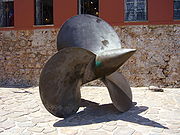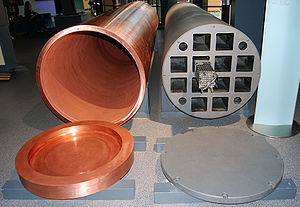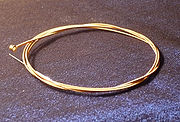
Phosphor bronze
Encyclopedia

Alloy
An alloy is a mixture or metallic solid solution composed of two or more elements. Complete solid solution alloys give single solid phase microstructure, while partial solutions give two or more phases that may or may not be homogeneous in distribution, depending on thermal history...
of copper
Copper
Copper is a chemical element with the symbol Cu and atomic number 29. It is a ductile metal with very high thermal and electrical conductivity. Pure copper is soft and malleable; an exposed surface has a reddish-orange tarnish...
with 3.5 to 10% of tin
Tin
Tin is a chemical element with the symbol Sn and atomic number 50. It is a main group metal in group 14 of the periodic table. Tin shows chemical similarity to both neighboring group 14 elements, germanium and lead and has two possible oxidation states, +2 and the slightly more stable +4...
and a significant phosphorus
Phosphorus
Phosphorus is the chemical element that has the symbol P and atomic number 15. A multivalent nonmetal of the nitrogen group, phosphorus as a mineral is almost always present in its maximally oxidized state, as inorganic phosphate rocks...
content of up to 1%. The phosphorus is added as deoxidizing agent during melting.
These alloys are notable for their toughness
Toughness
In materials science and metallurgy, toughness is the ability of a material to absorb energy and plastically deform without fracturing; Material toughness is defined as the amount of energy per volume that a material can absorb before rupturing...
, strength
Strength of materials
In materials science, the strength of a material is its ability to withstand an applied stress without failure. The applied stress may be tensile, compressive, or shear. Strength of materials is a subject which deals with loads, deformations and the forces acting on a material. A load applied to a...
, low coefficient of friction, and fine grain
Crystallite
Crystallites are small, often microscopic crystals that, held together through highly defective boundaries, constitute a polycrystalline solid. Metallurgists often refer to crystallites as grains.- Details :...
. The phosphorus also improves the fluidity
Fluidity
Fluidity may refer toIn science*reciprocal of viscosity*Cognitive fluidity*Membrane fluidity*Sexual fluidityOthers*Fluidity *Dark Fluidity – a literature magazine*Empire Fane ship...
of the molten metal and thereby improves the castability, and improves mechanical properties by cleaning up the grain boundaries
Grain boundary
A grain boundary is the interface between two grains, or crystallites, in a polycrystalline material. Grain boundaries are defects in the crystal structure, and tend to decrease the electrical and thermal conductivity of the material...
.
Industrial uses
Phosphor bronze is used for springsSpring (device)
A spring is an elastic object used to store mechanical energy. Springs are usually made out of spring steel. Small springs can be wound from pre-hardened stock, while larger ones are made from annealed steel and hardened after fabrication...
, bolts
Screw
A screw, or bolt, is a type of fastener characterized by a helical ridge, known as an external thread or just thread, wrapped around a cylinder. Some screw threads are designed to mate with a complementary thread, known as an internal thread, often in the form of a nut or an object that has the...
and various other items used in situations where resistance to fatigue, wear and chemical corrosion are required (e.g., a ship's propeller
Propeller
A propeller is a type of fan that transmits power by converting rotational motion into thrust. A pressure difference is produced between the forward and rear surfaces of the airfoil-shaped blade, and a fluid is accelerated behind the blade. Propeller dynamics can be modeled by both Bernoulli's...
s in a marine
Marine (ocean)
Marine is an umbrella term. As an adjective it is usually applicable to things relating to the sea or ocean, such as marine biology, marine ecology and marine geology...
environment). The alloy is also used in some dental bridges.
Grades A, C and E – C51000, 52100, 50700 are commonly used nonferrous spring alloys. The combination of good physical properties, fair electrical conductivity and moderate cost make Phosphor Bronze round, square, flat and special shaped wire desirable for many springs and electrical contacts and a wide variety of wire forms where cost of properties does not prescribe Beryllium copper
Beryllium copper
Beryllium copper , also known as copper beryllium, beryllium bronze and spring copper, is a copper alloy with 0.5—3% beryllium and sometimes with other alloying elements. Beryllium copper combines high strength with non-magnetic and non-sparking qualities. It has excellent metalworking, forming...
.
Spent nuclear fuel overpack

Oxygen-free copper
Oxygen-free copper or Oxygen-free high thermal conductivity copper generally refers to a group of wrought high conductivity copper alloys that have been electrolytically refined to reduce the level of oxygen to .001% or below....
can be alloyed with phosphorus
Phosphorus
Phosphorus is the chemical element that has the symbol P and atomic number 15. A multivalent nonmetal of the nitrogen group, phosphorus as a mineral is almost always present in its maximally oxidized state, as inorganic phosphate rocks...
(CuOFP alloy) to better withstand oxidizing conditions. This alloy has application as thick corrosion-resistant overpack for spent nuclear fuel
Spent nuclear fuel
Spent nuclear fuel, occasionally called used nuclear fuel, is nuclear fuel that has been irradiated in a nuclear reactor...
disposal in deep crystalline rocks.
Musical instruments

Alto saxophone
The alto saxophone is a member of the saxophone family of woodwind instruments invented by Belgian instrument designer Adolphe Sax in 1841. It is smaller than the tenor but larger than the soprano, and is the type most used in classical compositions...
manufactured by Yanagisawa
Yanagisawa Wind Instruments
Yanagisawa Wind Instruments is a Japanese woodwind company known for its range of professional grade saxophones. Along with Yamaha they are one of the leading manufacturers of saxophones in Japan....
). A saxophone
Saxophone
The saxophone is a conical-bore transposing musical instrument that is a member of the woodwind family. Saxophones are usually made of brass and played with a single-reed mouthpiece similar to that of the clarinet. The saxophone was invented by the Belgian instrument maker Adolphe Sax in 1846...
made from phosphor bronze is heavier than one made from brass
Brass
Brass is an alloy of copper and zinc; the proportions of zinc and copper can be varied to create a range of brasses with varying properties.In comparison, bronze is principally an alloy of copper and tin...
, due to its higher copper
Copper
Copper is a chemical element with the symbol Cu and atomic number 29. It is a ductile metal with very high thermal and electrical conductivity. Pure copper is soft and malleable; an exposed surface has a reddish-orange tarnish...
content, which gives greater mass
Mass
Mass can be defined as a quantitive measure of the resistance an object has to change in its velocity.In physics, mass commonly refers to any of the following three properties of matter, which have been shown experimentally to be equivalent:...
. Phosphor bronze saxophones have distinctive, reddish-orange hues, which look different to the yellow-gold color of standard lacquered brass. In addition to being more robust, phosphor bronze gives musical instruments tonal qualities which are slightly different to those made from the usual brass alloys. For example, although their designs are identical in every way apart from the metal used, the Yanagisawa A992 and T992 (phosphor bronze) alto and tenor saxophones sound noticeably "darker" than the A991 and T991 (brass) versions. However, other variables may affect an instrument's tone colors (e.g., mouthpiece design and physical characteristics of the player).
Additionally, phosphor bronze is sometimes used in brass instrument
Brass instrument
A brass instrument is a musical instrument whose sound is produced by sympathetic vibration of air in a tubular resonator in sympathy with the vibration of the player's lips...
s (e.g., Flugelhorn
Flugelhorn
The flugelhorn is a brass instrument resembling a trumpet but with a wider, conical bore. Some consider it to be a member of the saxhorn family developed by Adolphe Sax ; however, other historians assert that it derives from the valve bugle designed by Michael Saurle , Munich 1832 , thus...
s), plus percussion instrument
Percussion instrument
A percussion instrument is any object which produces a sound when hit with an implement or when it is shaken, rubbed, scraped, or otherwise acted upon in a way that sets the object into vibration...
s such as cymbal
Cymbal
Cymbals are a common percussion instrument. Cymbals consist of thin, normally round plates of various alloys; see cymbal making for a discussion of their manufacture. The greater majority of cymbals are of indefinite pitch, although small disc-shaped cymbals based on ancient designs sound a...
s and snare drums. Some acoustic instrument
String instrument
A string instrument is a musical instrument that produces sound by means of vibrating strings. In the Hornbostel-Sachs scheme of musical instrument classification, used in organology, they are called chordophones...
strings
Vibrating string
A vibration in a string is a wave. Usually a vibrating string produces a sound whose frequency in most cases is constant. Therefore, since frequency characterizes the pitch, the sound produced is a constant note....
for acoustic guitar
Steel-string acoustic guitar
A steel-string acoustic guitar is a modern form of guitar descended from the classical guitar, but strung with steel strings for a brighter, louder sound...
s, mandolin
Mandolin
A mandolin is a musical instrument in the lute family . It descends from the mandore, a soprano member of the lute family. The mandolin soundboard comes in many shapes—but generally round or teardrop-shaped, sometimes with scrolls or other projections. A mandolin may have f-holes, or a single...
s and violins are wrapped with this metal. Some harmonica
Harmonica
The harmonica, also called harp, French harp, blues harp, and mouth organ, is a free reed wind instrument used primarily in blues and American folk music, jazz, country, and rock and roll. It is played by blowing air into it or drawing air out by placing lips over individual holes or multiple holes...
reeds are made of phosphor bronze, such as those by the Suzuki
Suzuki
is a Japanese multinational corporation headquartered in Hamamatsu, Japan that specializes in manufacturing compact automobiles and 4x4 vehicles, a full range of motorcycles, all-terrain vehicles , outboard marine engines, wheelchairs and a variety of other small internal combustion engines...
brand.
Variants
Further increasing the phosphorus content leads to formation of a very hard compound Cu3P (copper phosphide), resulting in a brittleBrittle
A material is brittle if, when subjected to stress, it breaks without significant deformation . Brittle materials absorb relatively little energy prior to fracture, even those of high strength. Breaking is often accompanied by a snapping sound. Brittle materials include most ceramics and glasses ...
form of phosphor bronze, which has a narrow range of applications.
Around 2001, the Olin Corporation developed another phosphor bronze alloy comprising:
- ZincZincZinc , or spelter , is a metallic chemical element; it has the symbol Zn and atomic number 30. It is the first element in group 12 of the periodic table. Zinc is, in some respects, chemically similar to magnesium, because its ion is of similar size and its only common oxidation state is +2...
– 9.9% - TinTinTin is a chemical element with the symbol Sn and atomic number 50. It is a main group metal in group 14 of the periodic table. Tin shows chemical similarity to both neighboring group 14 elements, germanium and lead and has two possible oxidation states, +2 and the slightly more stable +4...
– 2.2% - IronIronIron is a chemical element with the symbol Fe and atomic number 26. It is a metal in the first transition series. It is the most common element forming the planet Earth as a whole, forming much of Earth's outer and inner core. It is the fourth most common element in the Earth's crust...
– 1.9% - PhosphorusPhosphorusPhosphorus is the chemical element that has the symbol P and atomic number 15. A multivalent nonmetal of the nitrogen group, phosphorus as a mineral is almost always present in its maximally oxidized state, as inorganic phosphate rocks...
– 0.03% - CopperCopperCopper is a chemical element with the symbol Cu and atomic number 29. It is a ductile metal with very high thermal and electrical conductivity. Pure copper is soft and malleable; an exposed surface has a reddish-orange tarnish...
– 85.97%
Olin developed this new alloy for use in electrical and electronic connectors. When assessed in strictly metallurgical terms it is not true phosphor bronze, but a form of iron-modified tin brass
Brass
Brass is an alloy of copper and zinc; the proportions of zinc and copper can be varied to create a range of brasses with varying properties.In comparison, bronze is principally an alloy of copper and tin...
.

